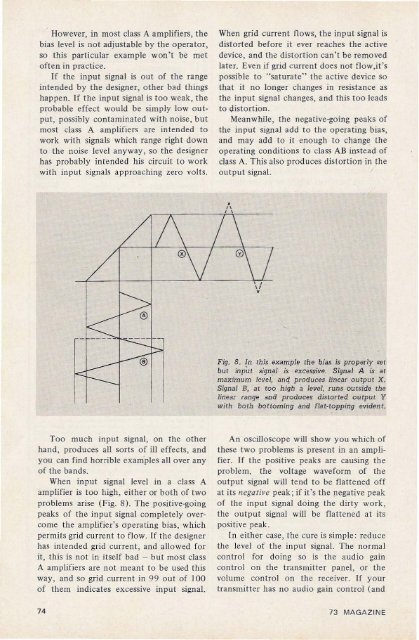illrrrrrrW
illrrrrrrW - Free and Open Source Software
illrrrrrrW - Free and Open Source Software
- No tags were found...
Create successful ePaper yourself
Turn your PDF publications into a flip-book with our unique Google optimized e-Paper software.
How ever , in mo st class A amplifiers, the<br />
bias level is no t adjustable by the opera tor,<br />
so this particular examp le won 't be met<br />
ofte n in pra cti ce.<br />
If th e in put signal is out of the range<br />
int ended by the designer, other bad things<br />
hap pen. If the input signal is too weak, the<br />
pro bable effec t would be simply low ou t<br />
put , possibly contamina te d with no ise, but<br />
most class A amplifiers are int ended to<br />
work with signa ls which range righ t down<br />
to th e noise level any way , so the designer<br />
has pro bably intended his circuit to work<br />
with input signa ls approaching zero volt s.<br />
When grid current flows, t he input signal is<br />
distorted before it ever reaches the act ive<br />
device, and the distortion can't be remo ved<br />
lat er. Even if grid cur rent does not flow.it's<br />
possible to «saturate" th e ac tive device so<br />
th at it no longer changes in resistance as<br />
the input signal changes, and this too leads<br />
to distortion .<br />
Meanw hile, the negative-going peaks of<br />
the in put signal add to th e o perating bias,<br />
and ma y add to it enou gh to change the<br />
op erating con ditions to class AB instead of<br />
class A. This also prod uces distortion in the<br />
a utput signal.<br />
@<br />
®<br />
Fig. 8, In this exam ple the bias is prop erly set<br />
bu t inp~t signal is excessive. SJgnal A is at<br />
maximum level,' anq prod uces linear output X.<br />
Signal B, at too high a level, runs outside the<br />
linear range and produ ces distorted output Y<br />
with bot h bottoming and flat·topping eviden t.<br />
Too mu ch input signal, on the other<br />
hand , pro duces all sorts of ill effec ts, and<br />
yo u can find ho rrible examples all over any<br />
of th e bands.<br />
When in put signal level in a class A<br />
amplifier is too high , either or both of two<br />
prob lems arise (Fig. 8). T he positive-going<br />
peaks of the input signal completely overcome<br />
th e amplifier 's op era ting bias, which<br />
permits grid current to flow . If the designer<br />
has intend ed grid cur rent, and allow ed for<br />
it, thi s is no t in itself bad - but most class<br />
A amplifiers are not mean t to be used this<br />
way , and so grid cur rent in 99 out of 100<br />
of th em indi cates excessive input signa l.<br />
74<br />
An osc illoscope will sho w you which of<br />
these two problems is present in an amplifier.<br />
If the pos itive peaks are causing the<br />
problem, the volta ge waveform of th e<br />
ou tput signal will tend to be flatten ed off<br />
at its negati ve peak ; if it 's th e negative peak<br />
of the inp ut signal doin g the dirt y wo rk ,<br />
the out put signal will be flattened at its<br />
positive peak.<br />
In either case, the cure is simple : reduce<br />
the level of th e input signal. The no rma l<br />
control for doing so is th e audio gain<br />
contro l on the transmitt er panel, or th e<br />
volume contro l on th e receiver. If your<br />
transmitter has no audio gain control (a nd<br />
73 MAGA Z INE

















